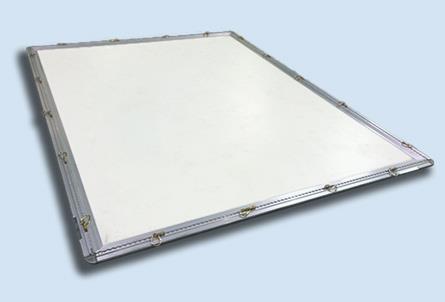Carbon Freight — a startup based in Pittsburgh, U.S.A. — is attacking this issue with flexible, lightweight cargo pallets that are 18% lighter than traditional pallets. “There hasn’t been much innovation in the air cargo industry, certainly not compared to the aerospace leaders’ focus on new materials and production processes that reduce weight,” notes CEO Glenn Philen. “Since cargo can represent a significant percentage of a fully loaded jet’s weight, it only makes sense to look at historic cargo storage and transportation product designs — which have been in use for decades — and ask how we can adapt them for the challenges of today.”
 Measuring 8 feet by 10.5 feet, freight cargo pallets have typically been constructed of aluminium. By integrating composites into the materials mix, Carbon Freight has been able to achieve a significant reduction in overall weight. This weight reduction allows a typical cargo plane to carry up to 1,365 pounds in additional freight, and it enables passenger flights to carry more people by reducing cargo load.
Measuring 8 feet by 10.5 feet, freight cargo pallets have typically been constructed of aluminium. By integrating composites into the materials mix, Carbon Freight has been able to achieve a significant reduction in overall weight. This weight reduction allows a typical cargo plane to carry up to 1,365 pounds in additional freight, and it enables passenger flights to carry more people by reducing cargo load.
While Carbon Freight’s innovative design decreases weight, at the same time it actually increases a pallet’s strength and durability significantly, compared with existing lightweight options. “Durability is a key characteristic for cargo pallets, because they need to fit together as closely as possible in the hold of an aircraft in order to optimise all available space,” explains Philen. “But they also take a lot of abuse, and they need to have some give. We’ve found that composite pallets initially present some durability challenges, but there are actually opportunities for increased durability over other options. They actually deliver a lot of positive performance characteristics that go beyond lower weight.”
The close proximity of pallets to one another, coupled with constant movement and handling, have created some engineering challenges for the Carbon Freight team. Says Philen, “We not only have to consider the loading stresses on our products created by the cargo, but also a wide range of contact stresses that occur as pallets are lifted, transported and packed together. There is a diverse set of complex forces that our design team needs to consider in order to deliver the best product durability over time.”

Structural simulation of a Carbon Freight pallet
Carbon Freight’s product development team has relied heavily on engineering simulation to understand and manage these diverse physical stresses. “We’ve been able to test different material thicknesses and fibre “Simulation has helped us model and understand our pallet structures to improve their overall strength and flexibility, while minimizing their potential for damage.” orientations without the time and expense of creating physical prototypes. When we do get to the physical testing stage, we’re really happy with the accuracy of our simulations,” noted Philen. Simulation has also been able to help Carbon Freight manage one of its biggest business challenges: securing regulatory approvals from the Federal Aviation Administration and other organisations. “One of the reasons that traditional aluminium pallets are so entrenched is that it’s difficult to secure approvals for a new product design,” Philen points out. “Everything that goes into an aircraft must be stringently tested and proven to be safe. As passengers, we want and need that high degree of confidence. But the numerous approvals present challenges that a startup like Carbon Freight has to overcome to compete in the global aerospace industry. Established companies have an advantage in navigating the approval process.”
By visually demonstrating how its pallets will perform under everyday stresses — and verifying their safe performance over time — engineering simulation has helped Carbon Freight progress through the regulatory approvals process. According to Philen, “Simulation via ANSYS has saved 50% in development time and hundreds of thousands of dollars in physical testing.” The company is on track to launch its pallets to the global marketplace in early 2017.
Despite the fact that simulation has helped reduce product weight by 18%, Carbon Freight executives recognise that there will be challenges involved in breaking into the global market. “Composite materials are more expensive than aluminium, which means a higher price point for our pallets. However, the new lightweight design of our products has the potential to save significant fuel costs and add revenues over their lifetime. We’re offering passenger airlines and freight carriers a very attractive value proposition, and we believe Carbon Freight has a bright future ahead,” concludes Philen.












